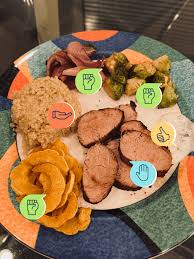Do you spend countless hours thinking about your next meal, even when you’ve just finished eating? You’re not alone. Studies show that 30% of adults regularly experience being obsessed with food, turning what should be a simple part of life into an all-consuming worry.
The constant mental chatter about calories, meal timing, and food choices can be exhausting. However, achieving a balanced diet doesn’t require this level of mental gymnastics. In fact, the solution often lies in doing less, not more.

The good news? Breaking free from food obsession is possible. Whether you’re caught in the cycle of restrictive eating or simply want to develop a healthier relationship with food, there are proven strategies that can help.
Let’s explore why food obsession happens and, more importantly, how you can overcome it to build a more peaceful relationship with eating.
Why Food Obsession Happens
Understanding food obsession starts with brain chemistry. The mesocorticolimbic pathway plays a central role in how we experience food pleasure and motivation [1]. This complex system involves multiple brain regions working together to create both the enjoyment of eating and the drive to seek out food.
The Brain’s Reward System
The brain processes food rewards through two distinct mechanisms. First, there’s the ‘liking’ component, which generates pleasure from eating. Second, there’s the ‘wanting’ component, which drives motivation to obtain food [2]. These systems can become particularly active with highly palatable foods that combine sugar, salt, and fat [3]. Consequently, when we eat these foods, neurons in reward regions become highly active, creating positive feelings that make us seek these foods regularly [3].
Impact of Past Dieting
Past dieting significantly influences food obsession. Research shows that dietary restriction alters how the brain responds to food, leading to increased preoccupation with eating [4]. Furthermore, studies have found that people who restrict their food intake experience more intense cravings and heightened responses to food cues [1].
During periods of restriction, the brain enters a survival mode. This biological response stems from our evolutionary past – when food was scarce, increased thoughts about food helped ensure survival [4]. Additionally, research from the Minnesota Starvation Experiment demonstrated that even healthy individuals developed extreme preoccupation with food when placed on restricted diets [4].

Environmental Triggers
The modern food environment presents numerous triggers that can intensify food obsession. Primary factors include:
- Increased exposure to food advertising [3]
- Social gatherings and celebrations [5]
- Work-related stress and time constraints [6]
- Easy access to highly processed foods [7]
Studies indicate that environmental triggers significantly influence eating behaviours, often without conscious awareness [8]. For instance, research shows that the presence of others can strongly affect food intake, yet most people attribute their eating decisions primarily to hunger and taste [8].
The combination of these biological mechanisms, past dietary behaviours, and environmental factors creates a complex web that can lead to food obsession. Understanding these underlying causes is the first step toward developing a more balanced relationship with food [6].
Signs You’re Obsessing Over Food
Recognising the signs of being obsessed with food marks the first step toward positive change. Research shows that food-related thoughts can become so persistent that they interfere with daily activities and social interactions [9].
Physical Signs
The body sends clear signals when food obsession takes hold. People experiencing food obsession often show unintentional changes in weight, both gains and losses [10]. Moreover, physical manifestations include:
- Stomach discomfort and digestive issues
- Sleep disturbances and fatigue
- Headaches and dizziness
- Changes in energy levels throughout the day
- Dental problems from altered eating patterns
These physical symptoms often appear alongside changes in eating behaviours. Notably, many individuals report eating until uncomfortably full or consuming food much faster than normal [11].

Mental Patterns
The mental aspects of food obsession can be particularly challenging. Studies indicate that people with food-related preoccupations spend unusually large amounts of time planning, buying, and preparing meals [9]. This fixation can lead to:
Primarily, individuals find themselves thinking about food even when not hungry [12]. The mind becomes caught in a cycle of food-related thoughts, making it difficult to focus on other tasks or conversations [13].
Subsequently, many people develop rigid rules about eating, followed by feelings of guilt when these rules are broken [14]. Research shows that this pattern creates a cycle where breaking self-imposed dietary restrictions leads to intense emotional distress [9].
The impact extends beyond meal times. Many individuals report avoiding social situations where food is present or bringing their own meals to events [9]. This behaviour stems from an overwhelming need to maintain control over eating habits.
Nevertheless, one of the most telling signs is the amount of mental energy devoted to food choices. Studies reveal that people experiencing food obsession often spend hours researching nutrition information and checking ingredient lists [15]. This preoccupation can interfere with work performance, relationships, and overall quality of life [12].
Breaking the Mental Food Loop
Breaking free from food-related thought patterns requires a systematic approach based on behavioural science. Research shows that cognitive-behavioural techniques effectively help master eating habits through mindfulness and thought pattern modification [16].
Understanding Your Triggers
Initially, identifying what sparks food-related thoughts forms the foundation of breaking the mental loop. Triggers generally fall into two categories:
- Emotional triggers: stress, anxiety, boredom, loneliness
- Environmental triggers: food advertisements, social events, specific locations, time of day
Primarily, these triggers activate the brain’s reward pathway, making it challenging to resist certain foods [17]. Research indicates that stress specifically increases cortisol levels, which impairs appetite regulation in the brain’s hypothalamus [2].
Creating New Thought Patterns
Cognitive restructuring plays a vital role in changing how you think about food. Rather than viewing food as a comfort tool, the goal is to see it as nourishment for your body [16]. This shift helps reduce guilt associated with eating and supports a healthier relationship with food.
Accordingly, mindfulness techniques help break the automatic response to triggers. Progressive Muscle Relaxation (PMR) teaches you to notice and release tension, essentially reducing stress-triggered eating behaviours [16]. Mindful eating has emerged as another powerful strategy, helping you develop greater awareness of hunger and fullness cues [18].
Building Better Habits
Undoubtedly, establishing new habits requires consistent practise. Research demonstrates that behaviour modification involves a comprehensive overhaul of eating behaviours through well-established psychological strategies [16].
Creating structured routines helps regain control over eating patterns. Specifically, this includes:
Setting realistic meal times to reduce impulsive eating Practising delayed gratification when cravings arise Developing alternative responses to emotional triggers
Generally, the process of systematically making foods less desirable, known as habituation, helps reduce their psychological power [19]. This approach, combined with regular physical activity, strengthens the brain’s rational decision-making abilities regarding food choices [2].
Likewise, tracking your emotional state helps remind you that thoughts about food might be tied to something else entirely [18]. By addressing these underlying factors, you can begin to break the cycle of food obsession and develop a more balanced relationship with eating.
Practical Steps to Food Freedom
Taking action toward food freedom requires practical, manageable steps. Research shows that giving yourself unconditional permission to eat reduces food obsession and helps build a healthier relationship with food [20].
Start With Small Changes
The path to freedom from being obsessed with food begins with small, consistent adjustments. Studies indicate that making gradual changes leads to lasting habits [21]. Begin by:
- Allowing yourself to eat previously ‘forbidden’ foods
- Drinking water regularly to distinguish between thirst and hunger
- Keeping a food-thought journal to identify patterns
- Creating structured meal times
Certainly, the process takes time, although research confirms that habituation—the process where foods become less exciting through regular exposure—naturally reduces cravings [1]. Besides, small changes help prevent the overwhelming feeling that often accompanies major dietary shifts.
Set Realistic Goals
Given these points, setting achievable goals becomes crucial for sustained progress. Research supports using the SMART framework—Specific, Measurable, Attainable, Realistic, and Time-bound goals [3]. In light of this approach, consider:
Track Your Progress: Write down your goals and monitor improvements. Studies show that documenting progress increases the likelihood of success [3].
Focus on Addition: Instead of restricting foods, concentrate on adding nutritious options to your meals. This strategy helps create a more positive relationship with eating [1].
Trust Your Body: Learn to recognise hunger and fullness signals. Research demonstrates that listening to these natural cues reduces food preoccupation [22].
Create Accountability: Working with a registered dietitian or joining support groups provides structure and motivation [23].
As a result of implementing these strategies, many individuals report decreased food obsession and improved eating patterns [1]. The key lies in maintaining consistency while being patient with the process. Studies confirm that those who allow themselves flexibility in their eating habits experience less guilt and fewer cravings [24].
Remember that progress isn’t linear. Research shows that giving yourself grace during setbacks strengthens long-term success [1]. Through steady implementation of these practical steps, you can gradually build a more peaceful relationship with food.
Building a Balanced Diet
Creating a balanced approach to eating marks a fundamental shift from being obsessed with food. Research shows that adopting food neutrality—where no foods carry moral value—supports a healthier relationship with eating [25].
Focus on Adding Foods
Primarily, the focus shifts from restriction to inclusion. Studies indicate that taking a positive, inclusive approach to food education shapes better eating patterns over time [25]. Therefore, rather than eliminating foods from your diet, concentrate on incorporating a variety of nutritious options.
Indeed, research demonstrates that every food provides some form of nourishment [26]. Even foods traditionally labelled as ‘unhealthy’ contain valuable nutrients that contribute to overall wellbeing. This understanding helps remove the unnecessary pressure of trying to eat ‘perfectly’ [4].
Listen to Hunger Signals
Understanding and responding to hunger signals forms the cornerstone of balanced eating. Your body communicates hunger through various physical signs:
- Light-headedness or difficulty focusing
- Stomach rumbling or discomfort
- Changes in energy levels
- Headaches or fatigue [27]
Markedly, research shows that starting meals when moderately hungry (around a level 3 on the hunger scale) and stopping when comfortably full (around level 6 or 7) supports better eating patterns [27]. This approach helps prevent both under and overeating.
Simultaneously, it’s crucial to recognise that hunger manifests differently throughout the day. Studies reveal that waiting too long between meals—typically more than 3-4 hours—can trigger intense cravings and lead to overeating [28]. Hence, maintaining regular eating patterns helps stabilise hunger signals.
Make Peace with All Foods
Evidently, developing food neutrality requires removing labels like ‘good’ or ‘bad’ from foods. Research confirms that labelling foods creates unnecessary hierarchy and can lead to feelings of guilt or shame [29]. Soon, these feelings transfer to self-worth, affecting overall mental wellbeing.
Nonetheless, making peace with food doesn’t mean ignoring nutrition. Instead, it involves understanding that all foods serve a purpose—whether providing energy, nutrients, or satisfaction [30]. Studies show that individuals who allow all foods into their diet maintain better control over their eating habits [30].
The process involves trusting your body’s natural ability to regulate food intake. Research indicates that when foods aren’t restricted or limited to specific times, the body naturally develops a balanced approach to eating [26]. This trust develops gradually as you learn to honour both physical and emotional hunger while respecting fullness cues [4].
Conclusion
Breaking free from food obsession requires understanding, patience, and consistent action. Studies clearly show that developing a balanced relationship with food happens gradually through mindful choices and self-compassion.
Therefore, success lies in recognising your triggers, implementing practical strategies, and trusting your body’s natural signals. Above all, remember that food neutrality – where no foods are labelled as good or bad – creates the foundation for lasting change.
Certainly, the journey toward food freedom might feel challenging at times. Research proves that small, steady changes lead to significant improvements in both physical and mental well-being. Your relationship with food can transform from one of obsession to one of peace and balance.
Ultimately, freedom from food obsession opens the door to a more fulfilling life – one where thoughts about food take their proper place alongside other daily activities, rather than dominating your mental space. Start implementing these evidence-based strategies today, and watch your relationship with food naturally evolve.
Want to learn more? Check out our other Blog posts HERE.
You can also check out The Performance Hub Podcast HERE.
To speak with a coach CLICK HERE.
References
[1] – https://thebalancednutritionist.com/finding-food-freedom/
[2] – https://www.ambulance.nsw.gov.au/__data/assets/pdf_file/0010/582787/20200511-Family-Fact-Sheet-Managing-eating-triggers.pdf
[3] – https://www.healthyliving.nsw.gov.au/wellbeing/for-you/how-to-set-goals-and-stick-to-them
[4] – https://www.forbes.com/sites/nomanazish/2022/03/30/how-to-build-a-healthy-relationship-with-food-according-to-experts/
[5] – https://www.medicalnewstoday.com/articles/binge-eating-disorder-triggers
[6] – https://pmc.ncbi.nlm.nih.gov/articles/PMC8535513/
[7] – https://onlinelibrary.wiley.com/doi/10.1111/add.15588
[8] – https://pubmed.ncbi.nlm.nih.gov/18823179/
[9] – https://www.healthline.com/nutrition/orthorexia-nervosa-101
[10] – https://www.nationaleatingdisorders.org/warning-signs-and-symptoms/
[11] – https://www.psychiatry.org/patients-families/eating-disorders/what-are-eating-disorders
[12] – https://www.webmd.com/mental-health/eating-disorders/binge-eating-disorder/mental-health-food-addiction
[13] – https://pmc.ncbi.nlm.nih.gov/articles/PMC8963447/
[14] – https://www.healthline.com/nutrition/8-symptoms-of-food-addiction
[15] – https://www.webmd.com/mental-health/eating-disorders/what-is-orthorexia
[16] – https://alhosnmedicalcenter.com/blog/behaviour-modification-techniques-utilising-cognitive-behavioural-strategies-overcome-emotional-eating-food-cravings-negative-thought-patterns/
[17] – https://www.virtua.org/articles/what-causes-food-addiction-and-what-are-the-signs
[18] – https://withinhealth.com/learn/articles/how-to-stop-thinking-about-food
[19] – https://www.emilyvaneck.com/how-to-stop-obsessing-about-food/
[20] – https://rubyoaknutrition.com/why-youre-obsessed-with-food-and-how-to-stop/
[21] – https://newsinhealth.nih.gov/2016/09/curb-your-eating
[22] – https://eatingessence.ca/2022/05/02/managing-food-preoccupation/
[23] – https://www.musiccitynutritionandwellness.com/nutrition-and-wellness-blog/how-to-stop-food-addiction-proven-strategies-for-lasting-change
[24] – https://pmc.ncbi.nlm.nih.gov/articles/PMC10490497/
[25] – https://www.publichealthontario.ca/-/media/Documents/F/24/food-neutrality-children-youth.pdf?rev=360ed6c00a7f42a0b3b9c02d0f2159b5&sc_lang=en
[26] – https://peaceandnutrition.com/what-is-food-neutrality/
[27] – https://extension.usu.edu/nutrition/research/learning-listening-hunger-fullness-cues
[28] – https://www.hopkinsmedicine.org/health/wellness-and-prevention/hunger-and-fullness-awareness
[29] – https://nuton.ca/what-is-food-neutrality/
[30] – https://www.healthline.com/nutrition/fixing-a-bad-relationship-with-food


